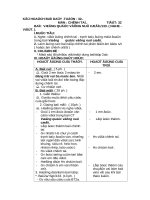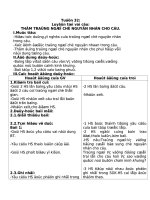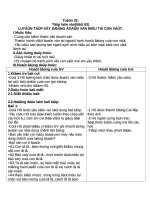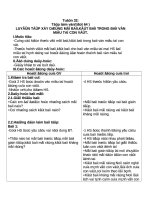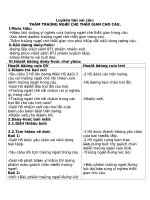English 4- week 32
Bạn đang xem bản rút gọn của tài liệu. Xem và tải ngay bản đầy đủ của tài liệu tại đây (827.32 KB, 12 trang )
<span class='text_page_counter'>(1)</span><div class='page_container' data-page=1>
Week 32 Period 123
Date of planning:30/4/2017
<b>UNIT 18: WHAT’S YOUR PHONE NUMBER?</b>
<b>Lesson 3: 4-5-6</b>
<b> I. AIMS. </b>
By the end of this lesson, Ps will be able to read specific information about Tom’s
picnic and complete a short paragraph about themselves.
1. Knowledge:
<b>2. Skills: speaking, listening and reading</b>
3. Attitude: Ps can talk about a picnic
II. TEACHING METHODS:
- Work in pairs , individual, in groups ….
III. TEACHING AIDS:
<i>1. Teacher’s: student’s and teacher’s book, pictures, cassette.</i>
<i>2. Students’: books, notebooks, workbooks.</i>
<i>3. Class organization:</i>
Class Date of teaching Absent pupils
4A
4B
5/5/2017
3/5/2017
………
………
IV. PROCEDURE:
Teacher’s activities Pupils’ activities
<b>I. Warm up:(10’)</b>
<b>PART D: SPEAKING</b>
<b>PART 1: Getting to know each other</b>
1.What is your name?
2.How old are you?
3.What is your favourite subject?
4.What do you do at Tet?
<b> 1. M1 2. M 2 3.M3 4.MĐ4</b>
<b>PART 2: Talking about a familiar object</b>
The test taker is given a carton box in which
there is a set of questions with the picture about the
<i>topic that students have learnt. The examiner tells the </i>
test taker to pick one strip into the box and answer the
<i>following questions. (“Please open the box and take </i>
<i>one strip.”)</i>
<i>Eg: </i>
</div>
<span class='text_page_counter'>(2)</span><div class='page_container' data-page=2>
5.What are they ?
6.How many people are there?
7 .What are they doing:
<b> 5. M 1 6. M1 7. M 4 </b>
<b>PART 3: Picture description</b>
<b>Now look at the picture. You have 30 seconds.</b>
<i><b>Suggested questions.</b></i>
8. What are they?
9. Where are they?
What’s there?
10.What’s your favourite
animal?
8.MĐ 2 9. MĐ 3 10.
MĐ 4
<b>II. New lesson:(20’)</b>
<b> 4. Read and tick.(8’)</b>
a. Pre-listening:
- T looks at the books and sets the table:
<i>How many pictures? What’s this?</i>
- Tell the class that they are going to read the text about
Tom’s picnic with his family, decide whether the five
statements are true or false and tick the correct answers.
- You may get ps to read the sentences under the text
and guess which sentence is true and which one is false.
b. While-listening:
- Give them time to do the task independently. Go
around and offer help, if necessary.
- Get ps to swap their answers before checking as a
class.
- If time allows, ask them more questions about the text
( e.g. Where does Tom have picnics with his family?
What does Tom like doing?
Key: 1 false 2 True 3 False 4 True
5 True
c. Post listening:
Look at the pictures.
Listen to the dialogues.
Ps answer the T’s
questions.
</div>
<span class='text_page_counter'>(3)</span><div class='page_container' data-page=3>
- Play the game: Lucky numbers.
<b>5. Let’s write. (8’)</b>
<b>a. Pre- writing:</b>
- Set the scence:
- Tell ps that they are going to complete a short
paragraph about themselves.
- Have them work in pairs or groups to discuss what
they are going to write in the gaps of the sentences.
Focus them on where usually go on Sundays and what
they wants to do there.
b. While- writing:
- Give ps time to do the task independently. Go around
offering help, if necessary.
- Get them to swap their answers before checking as a
class.
<b>c. Post writing:</b>
- Ask Ps to play a game: Whisper
<b>6. Project.(4’)</b>
- Tell ps that they are going to ask four classmates for
their phone numbers, and then report the results to the
class.
- Give each ps a card and ask them to copy the table
from the pupil’s book on their cards.
- Give ps time to ask their classmates for their phone
numbers and write them down.
- Have ps look at the table and tell the class their
classmates’ phone numbers. You may ask them to
<b>assume that they are reading from a phone book. </b>
Play the game.
Look at the pictures.
Listen to the teacher.
Identify the what someone
is doing.
Ps complete.
Ps do the task.
Swap their answers.
Play the game.
Listen to the teacher.
Ps work in groups of three.
Ps sing.
<b>III. Consolidation:(3’)</b>
? What’s the content of the lesson? T- Ps
<b>IV. Home-link: (2’)</b>
- Do exercises in the workbook. Learn by heart the
new words and structures.
Individually
* Comments:
</div>
<span class='text_page_counter'>(4)</span><div class='page_container' data-page=4>
Week 32 Period 124
Date of planning: 30/4/2017
<b>UNIT 19: WHAT ANIMAL DO YOU WANT TO SEE?</b>
<b>Lesson 1: 1-2</b>
<b>I. AIMS. </b>
By the end of this lesson, Ps will be able to ask and answer questions about
someone’s desire, using What animal do you want to see? I want to see….
1. Knowledge:
Sentence patterns: What animal do you want to see? I want to see….
Vocabulary:kangaoroo(s), crocodile(s), tiger(s), elephant(s)
<b>2. Skills: speaking, listening and reading</b>
3. Attitude: Ps can ask and answer questions about someone’s desire.
II. TEACHING METHODS:
- Work in pairs , individual, in groups ….
III. TEACHING AIDS:
<i>1. Teacher’s: student’s and teacher’s book, pictures, cassette.</i>
<i>2. Students’: books, notebooks, workbooks.</i>
<i>3. Class organization:</i>
Class Date of teaching Absent pupils
4A
4B
5/5/2017
3/5/2017
………
………
IV. PROCEDURE:
Teacher’s activities Pupils’ activities
<b>I. Warm up:(10’)</b>
<b>PART D: SPEAKING</b>
<b>PART 1: Getting to know each other</b>
1.What is your name?
2.How old are you?
3.What is your favourite subject?
4.What do you do at Tet?
<b> 1. M1 2. M 2 3.M3 4.MĐ4</b>
<b>PART 2: Talking about a familiar object</b>
The test taker is given a carton box in which
there is a set of questions with the picture about the
<i>topic that students have learnt. The examiner tells the </i>
test taker to pick one strip into the box and answer the
<i>following questions. (“Please open the box and take </i>
<i>one strip.”)</i>
<i>Eg: </i>
</div>
<span class='text_page_counter'>(5)</span><div class='page_container' data-page=5>
5.What are they ?
6.How many people are there?
7 .What are they doing:
<b> 5. M 1 6. M1 7. M 4 </b>
<b>PART 3: Picture description</b>
<b>Now look at the picture. You have 30 seconds.</b>
<i><b>Suggested questions.</b></i>
8. What are they?
9. Where are they?
What’s there?
10.What’s your favourite
animal?
8.MĐ 2 9. MĐ 3 10.
MĐ 4
<b>II. New lesson:(20’)</b>
<b>1. Look, listen and repeat. (5’)</b>
- T tell ps that they are going to read a story in which
Mai and Nam visit the zoo.
<b>- Have them look at the four pictures to identify the</b>
characters and the context in which the language is
<i>used. Ask them questions such as: Where are they?</i>
<i>What are they doing?( In picture a, Mai and Nam are</i>
<i>standing in the street and they want to go to the zoo. In</i>
<i>picture b, Nam ask Mai What animal do you want to</i>
<i>see? And Mai answers I want to see monkeys. In</i>
<i>picture c, they decide to see the monkeys. In picture d,</i>
<i>the monkey is reaching outside the bars of the cage and</i>
<i>Nam is a little afraid) Check understanding.</i>
- Play the recording so they can listen and repeat. Do
choral and individually repetition, pointing to the
characters speaking.
<b>- Play the recording again for Ps to listen and repeat.</b>
- If time allow, ask ps to role- play the story in pairs.
<b>2. Point and say.(12’)</b>
a. Vocabulary:
Look and listen
Look at the pictures and
answer the questions.
Listen and repeat in choral
and individual.
Look, listen and repeat in
choral then individual.
Listen and repeat.
T – W – C
</div>
<span class='text_page_counter'>(6)</span><div class='page_container' data-page=6>
<i>- Teach the names: kangaroo, crocodile, tiger,</i>
<i>elephant.</i>
- Checking: Slap the board
b. Model sentences:
<i>A: What animal do you want to see ? </i>
<i>B: I want to see kangaroos.</i>
- Concept check: intonation, using
c. Practice:
<b>- Tell Ps that they are going to practise asking and</b>
answering questions about what animal someone wants
to see, using What animal do you want to see? I want to
see…
- Have them look at the bubbles to understand how to
use the language. Ask them to look at the four pictures
to identify the zoo animals. - Point to the first picture
and model the task with one pupil, using the
expressions in the bubbles and the word under each
picture.Ask ps to say the sentences chorally and
individually. Repeat the same procedure with the rest of
the pictures.
- Ask them to practise in pairs, using the prompts in the
bubbles and the words under the pictures.
- Select some pairs to role- play the dialogue in front of
the class.
<b>Work in pairs. Ask your partners’ what animal they</b>
<b>want to see at the zoo.(3’)</b>
- Tell ps that they are going to practise asking and
answering questions about what animal someone wants
to see.
- Ask them work in pairs: one asks the question and
other givers the answer. Teach ps more words for zoo
animals, if necessary
- Monitor the activity and offer help, if necessary.
- Select some pairs of ps to role-play the dialogue in
<b>front of the class. </b>
O – P -> C – P
Ps practise asking and
answering.
Ps work in pairs.
Ps work in pairs.
Role play
Listen.
Work in pairs to ask and
asnswer.
Ps act out.
<b>III. Consolidation:(3’)</b>
? What’s the content of the lesson? T- Ps
<b>IV. Home-link: (2’)</b>
- Do exercises in the workbook. Learn by heart the
new words and structures.
Individually
</div>
<span class='text_page_counter'>(7)</span><div class='page_container' data-page=7>
………
………
……….
Week 32 Period 125
Date of planning: 30/4/2017
<b>UNIT 19: WHAT ANIMAL DO YOU WANT TO SEE?</b>
<b>Lesson 1: 3-4-5</b>
<b>I. AIMS. </b>
By the end of this lesson, Ps will be able to listen and match the character to the
correct picture and write what the children want to see.
1. Knowledge:
Sentence patterns: Revision
Vocabulary: Revision
<b>2. Skills: speaking, listening and reading</b>
3. Attitude: Ps can talk what the children want to see.
II. TEACHING METHODS:
- Work in pairs , individual, in groups ….
III. TEACHING AIDS:
<i>1. Teacher’s: student’s and teacher’s book, pictures, cassette.</i>
<i>2. Students’: books, notebooks, workbooks.</i>
<i>3. Class organization:</i>
Class Date of teaching Absent pupils
4A
4B
………
………
IV. PROCEDURE:
Teacher’s activities Pupils’ activities
<b>I. Warm up:(10’)</b>
<b>PART D: SPEAKING</b>
<b>PART 1: Getting to know each other</b>
1.What is your name?
2.How old are you?
3.What is your favourite subject?
4.What do you do at Tet?
<b> 1. M1 2. M 2 3.M3 4.MĐ4</b>
<b>PART 2: Talking about a familiar object</b>
The test taker is given a carton box in which
there is a set of questions with the picture about the
<i>topic that students have learnt. The examiner tells the </i>
test taker to pick one strip into the box and answer the
</div>
<span class='text_page_counter'>(8)</span><div class='page_container' data-page=8>
<i>following questions. (“Please open the box and take </i>
<i>one strip.”)</i>
<i>Eg: </i>
5.What are they ?
6.How many people are there?
7 .What are they doing:
<b> 5. M 1 6. M1 7. M 4 </b>
<b>PART 3: Picture description</b>
<b>Now look at the picture. You have 30 seconds.</b>
<i><b>Suggested questions.</b></i>
8. What are they?
9. Where are they? What’s
there?
10.What’s your favourite
animal?
8.MĐ 2 9. MĐ 3 10.MĐ 4
<b>II. New lesson:(20’)</b>
<b> 3. Listen and match.(8’)</b>
a. Pre-listening:
- T looks at the books and sets the scence:
<i><b> How many pictures are there? Who’s this? What</b></i>
<i>are they?</i>
- Tell the class that they are going to listen to three
dialogues about what animals Tony, Tom and Linda
want to see and match each character to the correct
picture.
- Ask ps to look at the pictures to identify the
characters(1. Tony.2. Tom. 3. Linda)and the zoo
animals(a. Crocodiles .b. Tiger . c. Monkeys). Check
understanding.
b. While-listening:
- Play the recording more than once, if necessary. Ask
ps to listen and match the pictures.
- Get ps to swap their answers befor you check as a
class.
Answer T’s questions
Look at pictures and
answer the questions.
Listen and do the task.
Work individual
Listen again to check.
- Work in pairs.
</div>
<span class='text_page_counter'>(9)</span><div class='page_container' data-page=9>
Key: 1c 2a 3b
c. Post listening:
- Play a game: Musical box
<b>4. Look and write.(7’)</b>
<b>a. Pre- writing:</b>
- Tell ps that they are going to write what the children
want to see, using the picture cues.
- Ask them look at the four pictures to identify what
the children want to see in each picture. (1.
Crocodiles 2. Monkey 3. Kanaroos 4. Tigers).
Then ask them to read the questions.
- Draw their attention to the different pronouns he,
she and they in the questions. After that, have them
write the answers in complete sentences. Get ps to
work in pairs, if necessary.
b. While- writing:
- Give ps time to do the task independently.
- Get them to swap their answers before checking as a
class.
Key: 1. He wants to see crocodile 2. She wants to
see monkeys.
3. They want to see kangarros 4. They want to
see tigers
c. Post- reading:
- Play the game: Whisper
- Guide how to play
<b>5. Let’s play. (5’)</b>
- Tell ps that they are going to play the game
Charades. Follow the procedure in Games in
Introduction.
- Show a ps the name of a zoo animal. That ps must
act out the animal for the rest of the class to guess.
The quickest ps to say the name of the animal for the
rest of the class to guess. The quickest ps to say the
name of the animal get a point. Then select another ps
to mime another animal. The ps who gets the most
point at the end of the game is the winner.
<b>- Moniter the activity and offer helf, if necessary. </b>
Role play.
Look at the book.
Answer T’s questions.
Read words.
Do the task.
Compare their answers in
pairs.
Play the game.
Listen.
Play the game.
Listen.
Ps work in groups.
Play the game in pairs.
<b>III. Consolidation:(3’)</b>
? What’s the content of the lesson? T- Ps
<b>IV. Home-link: (2’)</b>
</div>
<span class='text_page_counter'>(10)</span><div class='page_container' data-page=10>
new words and structures.
* Comments:
………
………
……….
Week 32 Period 126
Date of planning: 30/4/2017
<b>UNIT 19: WHAT ANIMAL DO YOU WANT TO SEE?</b>
<b>Lesson 2: 1-2-3</b>
<b>I. AIMS. </b>
By the end of this lesson, Ps will be able to use the words and phrases related to the
topic Zoo animals, accept reasons, using I like…. Because…./ I don’t like…..
because….
1. Knowledge:
Sentence patterns: I like…. Because…./ I don’t like….. because….
Vocabulary:scary, big, beautiful, fast
<b>2. Skills: speaking, listening and reading</b>
3. Attitude: Ps can talk about zoo animals, accept reasons.
II. TEACHING METHODS:
- Work in pairs , individual, in groups ….
III. TEACHING AIDS:
<i>1. Teacher’s: student’s and teacher’s book, pictures, cassette.</i>
<i>2. Students’: books, notebooks, workbooks.</i>
<i>3. Class organization:</i>
Class Date of teaching Absent pupils
4A
4B
………
………
IV. PROCEDURE:
Teacher’s activities Pupils’ activities
<b>I. Warm up:(5’)</b>
Spend a few minutes revising the previous lesson by
playing Charades with the words for zoo animals.
Groupwork
<b>II. New lesson:(30’)</b>
<b> 1. Look, listen and repeat.(7’)</b>
- Tell ps that they are going to read a conversation in
which Linda and Nam ask and answer questions
about zoo animals.
- Ask them look at the pictures to identify the context
in which the language is used. Ask them questions
<i>such as: Who are they? ? Where are they?What are</i>
<i>they doing?(Linda and Nam are at the zoo. They are</i>
Look and listen
</div>
<span class='text_page_counter'>(11)</span><div class='page_container' data-page=11>
<i>looking at different animals. In picture a, Linda ask</i>
<i>Nam what animal do you like?And Nam say I like</i>
<i>monkeys. In picture b, he explains why he likes</i>
<i>monkeys using Because they’re funny. In picture c,</i>
<i>Nam say that he does not like tigers. In picture d, he</i>
<i>explain why he does not like tigers, using Because</i>
<i>they are scary.) Check understanding.</i>
- Play the recording a few times for ps to listen and
repeat. Do choral and individually repetition, pointing
to the characters speaking.
<b>- Play the recording again for Ps to listen and repeat.</b>
<b>2. Point and say.(16’)</b>
a. Vocabulary:
<i>- Teach the adjectives under the pictures: scary, big,</i>
<i>beautiful and fast.</i>
<i>- Checking: Slap the board</i>
b. Model sentences:
<i> I like zebras because they are beautiful.</i>
<i>I don’t like tighers because they’re scary.</i>
- Concept check: intonation, using
c. Practice:
- Tell ps that they are going to practise expressing
reasons why they like/ do not like some animals,
using I like/ don’t like… because….
<b>- Have them look at the bubbles to identify the</b>
language used to express reasons. - Point to the first
picture and model the task with a pupil, using the
sentences in the bubbles and the words under the first
picture. Do choral and individual repetition and then
practise in pairs. Repeat the same procedure with the
rest of the pictures.
- Ask them practise in pairs to express resasons why
they like or do not like the animals, using the prompts
in the bubbles and the words under the pictures.
- Select some ps to role- play the dialogue in front of
the class. Monitor the activity and offer help, if
necessary.
<b>3. Let’s talk.(7’)</b>
- Tell Ps that they are going to revise what they have
learnt in L1 and 2. using facts about themselves.
- Model the task with one pupil
- Put the sentences on the board and do choral and
Listen and repeat in choral
and individual.
Look, listen and repeat in
choral then individual.
Listen and repeat.
T – W – C
H – H
O – P -> C – P
Ps practise asking and
answering.
Ps work in pairs.
Ps work in pairs.
Role play
</div>
<span class='text_page_counter'>(12)</span><div class='page_container' data-page=12>
individual repetition.
- Ask them to work in pairs: one ps asks the questions
and the other gives the answers.
- Call a few pairs to act out their dialogue in front of
<b>the class. </b>
Work in pairs to ask and
asnswer.
Ps act out.
<b>III. Consolidation:(3’)</b>
? What’s the content of the lesson? T- Ps
<b>IV. Home-link: (2’)</b>
- Do exercises in the workbook. Learn by heart the
new words and structures.
Individually
* Comments:
………
………
……….
</div>
<!--links-->
